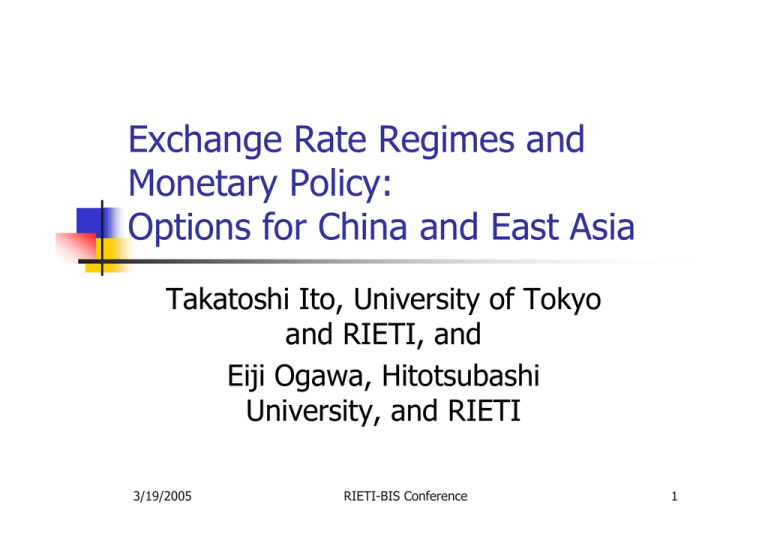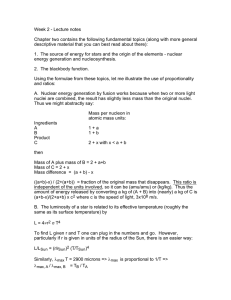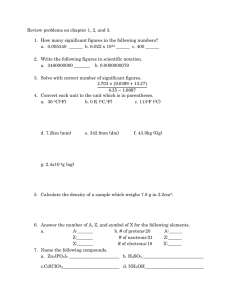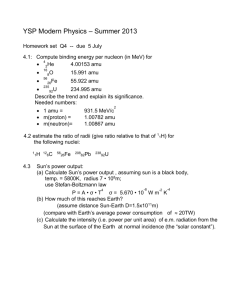Exchange Rate Regimes and Monetary Policy: Options for China and East Asia
advertisement

Exchange Rate Regimes and Monetary Policy: Options for China and East Asia Takatoshi Ito, University of Tokyo and RIETI, and Eiji Ogawa, Hitotsubashi University, and RIETI 3/19/2005 RIETI-BIS Conference 1 Contents Theory: Impossible Trinity Theory: IS-balance Theory: Balassa-Samuelson Exchange Rate Policy in China AMU and Deviation Measurement for coordinated exchange rate policies. 3/19/2005 RIETI-BIS Conference 2 Theory I: relationship between the exchange rate & Monetary Policy Choosing one exchange rate regime puts constraints on monetary policy, sometime severe, sometime moderate The fixed exchange rate regime implies that domestic monetary policy cannot pursue domestic price stability Monetary policy will influences on (pressures on) the exchange rate movements Pursuit of monetary policy inconsistent with the exchange rate regime will result in a collapse of the regime. 3/19/2005 RIETI-BIS Conference 3 Impossible Trinity: cannot have capital mobility, fixed exch rate & independent Monetary Policy China Capital mobility No Fixed Exch Independen rate t M policy Yes Yes Korea, Thai, Yes Singapore No Yes Hong Kong Yes No 3/19/2005 Yes RIETI-BIS Conference 4 Why impossible? Lessons from the Asian Crisis Suppose (yes, yes, yes) Strong growth Æ Capital inflows Æ intervene to defend the peg Sterilize (not to change the interest rate and domestic inflation) then more capital inflows with increasingly short-term Unsterilize (so that inflow pressure will ease) then domestic inflation and bubble Either exit to appreciation or sudden reversal of the flow and currency crisis 3/19/2005 RIETI-BIS Conference 5 Theory II: Saving Investment Identity Domestic Saving-Investment surpluses = Trade Surpluses: (S-I) + (T-G) = Export – Import Any Surpluses/deficits in current account has corresponding capital flows (Ex-Im) = Private Capital Outflows + Reserve accumulation 3/19/2005 RIETI-BIS Conference 6 Examples (S-I)+(T-G)=(EX-IM)=KOutflo+ResAcc Japan +++ -China ++ US 3/19/2005 - -- -- 0 + + 0 + -- +++ RIETI-BIS Conference 7 Implications of theory Sudden government deficits result in current account deficits (twin deficits of the US) Decline in domestic spending result in current account surpluses and capital outflow (Japan) More capital inflows means more reserve accumulation (China) 3/19/2005 RIETI-BIS Conference 8 Theory III: Balassa-Samuelson Empirical regularities: When the economy is growing very fast (Japan in the 1960s and China now), innovations tend to occur tradable sectors relative to nontradable sectors Relative prices change so that nontradable prices go up faster than tradable prices Tradable prices have PPP with foreign countries Relevance to China: Inflation or nominal exchange rate appreciation 3/19/2005 RIETI-BIS Conference 9 Is the fixed exchange rate regime good for the country? Foreign reserves will increase and decrease depending on current accounts and private capital flows (interventions are passive) Unsustainable if reserves go to zero (not likely in China) Domestic monetary policy is at the mercy of FRB; the Interest rate cannot be much different from the US Low interest rate Æ bubble High interest rate Æ recession 3/19/2005 RIETI-BIS Conference 10 Timing of exit When the economy is growing very fast (Japan in the 1960s and China now), innovations tend to occur tradable sectors relative to nontradable sectors 3/19/2005 RIETI-BIS Conference 11 If not peg, what else? Review of the Exchange rate regimes in East Asia Important to recognize that East Asia depends on each other and influence on each other Chinese exchange rate policy has a large impact on East Asia 3/19/2005 RIETI-BIS Conference 12 A variety of exchange rate regimes in East Asia Free (lightly managed) float: Japan, Korea, the Philippines, Singapore (Heavily) Managed float: Indonesia, Thailand, Cambodia, Lao, Vietnam Fixed: China, Malaysia Currency board: Hong Kong, Brunei Multiple Exchange Rates: Myanmar 3/19/2005 RIETI-BIS Conference 13 Recent linkages of East Asian currencies to US$ Regression equation: ∆ log e hom e / SFR = a0 + a1∆ log eUSD / SFR + a2 ∆ log e JPY / SFR + a3∆ log eeuro / SFR + ε t Use daily data to regress the equation for each quarter of the sample period from 1999 to 2003. a1 : linkages of home currency to the US$ or weight on the US$ 3/19/2005 RIETI-BIS Conference 14 Thai baht’s linkage to US$ Change of the Weight on US dollar - Thai baht, 1999.1Q-2003.4Q Weight on US dollar (%) 140 Weight on US dolalr Weight on US dolalr + 2*Standard errors Weight on US dolalr - 2*Standard errors 120 100 80 60 40 20 0 1999 1999 1999 1999 3/19/2005 2000 2000 2000 2000 2001 2001 2001 2001 2002 RIETI-BIS Conference 2002 2002 2002 2003 2003 2003 2003 15 Korean won’s linkage to US$ Change of the Weight on US dollar - Korean won, 1999.1Q-2003.4Q Weight on US dollar (%) 140 Weight on US dolalr Weight on US dolalr + 2*Standard errors Weight on US dolalr - 2*Standard errors 120 100 80 60 40 20 0 1999 1999 1999 1999 3/19/2005 2000 2000 2000 2000 2001 2001 2001 2001 2002 RIETI-BIS Conference 2002 2002 2002 2003 2003 2003 2003 16 Chinese yuan: weights on US$ Change of the Weight on US dollar - Chinese Yuan, 1999.1Q-2003.4Q Weight on US dollar (%) 140 Weight on US dolalr Weight on US dolalr + 2*Standard errors Weight on US dolalr - 2*Standard errors 120 100 80 60 40 20 0 1999 1999 1999 1999 3/19/2005 2000 2000 2000 2000 2001 2001 2001 2001 2002 RIETI-BIS Conference 2002 2002 2002 2003 2003 2003 2003 17 Capital inflows have supported unsustainable US CA deficits The US current account deficit was not sustainable from the perspectives based on both the domestic investment-saving relationships and the international trade flows. => The rapid growth in the current account deficit from the mid of 1990s together with the worsening international investment position has not satisfied the external “budget constraint” of the United States. The US current account deficit has been financed by the international capital inflows in the long run. => The balance of payments as a whole has been sustainable. 3/19/2005 RIETI-BIS Conference 18 Structural changes in the capital flows and the US CA deficits If the recent changes in the capital inflows to the United States (the decreases in the capital inflows into the United States from European countries) were structural and persistent, the U.S. current account deficits might not be financed by the capital inflows any longer. It might cause unsustainability of the US current account and, in turn, depreciation of the US$. 3/19/2005 RIETI-BIS Conference 19 Reaction to the US$ depreciation Two groups in terms of reaction to the US dollar depreciation in East Asia (1) Free floating or managed floating: the currencies have appreciated against the US dollar (2) Officially or unofficially dollar pegging: the currencies have been fixed against the US dollar. However, they have been depreciating the former group currencies. The latter group carry all of the stress from the depreciation of the US dollar to the former group. 3/19/2005 RIETI-BIS Conference 20 Chinese exchange rate system 1. 2. 3. Adverse effects of the Chinese exchange rate system to the other East Asian countries’ choice of the exchange rate system China should adopt more flexible system Intermediate system (Basket + Band + Crawling) Target a currency basket (US$, JPY, euro) from a viewpoint of international trade partners and FDI Band can afford room for domestic monetary policy to the monetary authorities. Crawling should be consistent with the domestic monetary policy. 3/19/2005 RIETI-BIS Conference 21 AMU as a measurement for coordinated exchange rate policies We propose a deviation measurement for coordinated exchange rate policies to enhance the monetary authorities’ surveillance process. Estimate Asian Monetary Unit (AMU), a weighted average of the East Asian currencies. Calculate deviation indicators from benchmark rate for the estimated AMU. We can use the deviation indicators to identify how much each of the East Asian currencies deviates from the benchmark rate for each of East Asian currencies in terms of the AMU. 3/19/2005 RIETI-BIS Conference 22 Methodology to estimate the AMU Member countries ASEAN10 + Japan, China and Korea Sampled period from January 1999 to November 2004 To follow the methodology to calculate the ECU 3/19/2005 RIETI-BIS Conference 23 The basket weights of AMU We try to use four different kinds of economic indicators. 1. 2. 3. 4. Trade volume Nominal GDP GDP measured at PPP International reserves (minus Gold) We choose the most stable AMU vis-àvis the basket currency among them. 3/19/2005 RIETI-BIS Conference 24 Shares in the AMU weights and calculated AMU weights Table 2. Indicators of AMU weights and calculated AMU weights (AMU vis-a-vis the basket currency*) Exchange Rate currency units for 1basket currency* ave. of Jan 1999 BRUNEI $ CAMBODIA RIEL CHINESE YUAN INDONESIAN RUPIAH JAPANESE YEN KOREAN WON LAOS KIP 1.7797 4065.79 8.7800 8974.89 120.07 1246.11 4457.56 4.0316 6.6309 40.7302 MALAYSIAN MYANMAR PHILIPPINE SINGAPORE RINGGIT KYAT PESO $ THAI BAHT VIETNAMESE DONG 1.7800 38.9109 14726.17 <Indicators of AMU weights, %> Share of trade volume 0.29 0.33 14.22 3.38 26.94 11.35 0.18 11.91 0.58 5.69 15.88 7.04 2.20 Share of Nominal GDP 0.07 0.05 16.81 1.68 69.40 5.65 0.02 1.27 - 1.15 1.45 1.97 0.48 Share of GDP measured at PPP 0.04 0.15 47.06 4.51 32.45 5.68 0.06 1.61 - 2.52 0.90 3.42 1.60 Share of International Reserves 0.07 0.06 27.41 4.17 39.59 6.78 0.02 4.70 0.06 1.70 9.78 5.30 0.37 Share of trade volume 0.0052 13.4707 1.2484 303.6043 32.3517 141.4752 8.1922 0.4802 0.0382 2.3161 0.2827 2.7391 323.7570 Share of Nominal GDP 0.0012 2.0832 1.4757 150.8786 83.3317 70.3876 1.0089 0.0513 0.0000 0.4675 0.0258 0.7666 70.5763 Share of GDP measured at PPP 0.0008 6.0301 4.1321 404.6478 38.9575 70.7321 2.6761 0.0650 0.0000 1.0276 0.0160 1.3300 235.8054 Share of International Reserves 0.0012 2.4205 2.4068 374.5547 47.5370 84.5175 0.9173 0.1893 0.0038 0.6905 0.1740 2.0609 54.1708 <AMU weights> Notes: All figures are calculated by authors. Nominal GDP and International Reserves (minus Gold) data are from International Financial Statistics, IMF. All trade data are from Direction of Trade of IMF. GDP measured at ppp are from World Development Report, World Bank. All exchange rates are from Datastream. Indicators of AMU weights are calculated by the data in 1998. * The basket currency is composed by the US dollar and the euro. The basket weight is depend on the trade share of each country/area against 13 sampled East Asian countries. Each weights is 51.7% and 48.3% for the US dollar and the euro, respectively. 3/19/2005 RIETI-BIS Conference 25 Fluctuations in AMUs (vis-àvis basket currency) Figure 3. The estimated AMU vis-a-vis the basket currency Feb 1999-Nov 2004 AMU v.s. basket currency Jan 1999=1 1.2 AMU-trade volume weight AMU-nominal GDP weight AMU-GDP measured at ppp weight AMU-international reserve weight AMU-nominal GDP weight 1.15 1.1 AMU-GDP measured at ppp weight 1.05 AMU-international reserve weight 1 AMU-trade volume weight 0.95 2004/10/1 2004/8/1 2004/6/1 2004/4/1 2004/2/1 2003/12/1 2003/10/1 2003/8/1 2003/6/1 2003/4/1 2003/2/1 RIETI-BIS Conference 2002/12/1 2002/10/1 2002/8/1 2002/6/1 2002/4/1 2002/2/1 2001/12/1 2001/10/1 2001/8/1 2001/6/1 2001/4/1 2001/2/1 2000/12/1 2000/10/1 2000/8/1 2000/6/1 2000/4/1 2000/2/1 3/19/2005 1999/12/1 1999/10/1 1999/8/1 1999/6/1 1999/4/1 1999/2/1 0.9 26 Choose the most stable AMU Table 3. Fluctuation of estimated AMU vis-a-vis the basket currency* Share of trade volume Share of Nominal Share of GDP GDP measured at PPP Share of International Reserves <level> max min average std. dev. <rate of change, %> max min average std. dev. 1.1320 0.9463 1.0169 0.0486 1.1847 0.9516 1.0345 0.0566 1.1519 0.9644 1.0348 0.0478 1.1520 0.9590 1.0306 0.0481 1.2677 -2.0006 -0.0021 0.3173 2.3127 -2.5231 0.0012 0.4718 1.2113 -2.0024 -0.0016 0.3106 1.4524 -2.1157 -0.0007 0.3464 Notes: All figures are calculated by authors. * The basket currency is composed by the US dollar and the euro. The basket weight is depend on the trade share of each country/area against 13 sampled East Asian countries. Each weights is 51.7% and 48.3% for the US dollar and the euro, respectively. 3/19/2005 RIETI-BIS Conference 27 Measurement of the deviation indicators We use the estimated AMUs with the weights based on GDP measured at PPP Trade volume to measure the deviation of actual rate from a benchmark rate for 13 East Asian currencies. 3/19/2005 RIETI-BIS Conference 28 To choose the benchmark period for AMU In the benchmark period, the total current account of trade should be balanced, or more close to be balanced. Table 4. Trade account (net) within 13 East Asian countries 13 East Asian countries with Japan * within 13 East Asian countries with World Total 1999 2000 2001 2002 2003 -32,065 -37,239 -23,997 -40,027 -55,724 4,819 -6,562 1,953 12,289 27,727 215,324 180,439 122,893 160,906 187,868 (unit: million of US dollar) Notes: All figures are calculated by authors. Trade data are from Direction of Trade (IMF). * The figure of current account with Japan is the total amount of current account(net) with 12 East Asian countries. 3/19/2005 RIETI-BIS Conference 29 How to calculate the deviation indicator Using the estimated AMU, we calculate the deviation indicator as follows: benchmark rate : each currency’s exchange rate vis-à-vis AMU at the benchmark period actual exchange rate : exchange rate of each currency vis-à-vis AMU which fluctuates as the each currency actually move Deviation Indicator (%) = benchmark rate of a currency/A MU - actual exchange rate of a currency/A MU × 100 benchmark rate of a currency/A MU (1) 3/19/2005 RIETI-BIS Conference 30 The deviation indicators in the case of AMU based on GDP measured at PPP Figure4. The movement of the deviation indicators from January 2002 to November 2004 (%) (in the case of AMU weight based on GDP measured at PPP) 20.0 Indonesian rupiah 15.0 10.0 BRUNEI $ Korean won Japanese yen CAMBODIA RIEL 5.0 CHINESE YUAN Thai baht Singapore$ Brunei$ INDONESIAN RUPIAH JAPANESE YEN 0.0 Malaysian ringgit Myanmar kyat KOREAN WON -5.0 LAOS KIP Chinese yuan Laos kip MALAYSIAN RINGGIT MYANMAR KYAT -10.0 Cambodia riel Vietnamese dong PHILIPPINE PESO SINGAPORE $ -15.0 Philippine peso THAI BAHT -20.0 VIETNAMESE DONG 2004/11/1 2004/10/1 2004/9/1 2004/8/1 2004/7/1 2004/6/1 2004/5/1 2004/4/1 2004/3/1 RIETI-BIS Conference 2004/2/1 2004/1/1 2003/12/1 2003/11/1 2003/10/1 2003/9/1 2003/8/1 2003/7/1 2003/6/1 2003/5/1 2003/4/1 2003/3/1 2003/2/1 2003/1/1 2002/12/1 2002/11/1 2002/9/1 2002/10/1 2002/8/1 2002/7/1 3/19/2005 2002/6/1 2002/5/1 2002/4/1 2002/3/1 2002/2/1 2002/1/1 -25.0 31 The deviation indicators in the case of AMU based on trade volume Figure5. The movement of the deviation indicators from January 2002 to November 2004 (%) (in the case of AMU weight based on trade volume) 20.0 Indonesian rupiah 15.0 10.0 BRUNEI $ Korean won Japanese yen 5.0 CAMBODIA RIEL CHINESE YUAN 0.0 Thai baht INDONESIAN RUPIAH JAPANESE YEN Singapore$ B i$ -5.0 KOREAN WON Malaysian ringgit Myanmar kyat LAOS KIP -10.0 Chinese yuan Cambodia riel -15.0 MALAYSIAN RINGGIT MYANMAR KYAT Laos Vietnamese dong PHILIPPINE PESO SINGAPORE $ Philippine peso THAI BAHT -20.0 2004/11/1 2004/10/1 2004/9/1 2004/8/1 2004/7/1 2004/6/1 2004/5/1 2004/4/1 RIETI-BIS Conference 2004/3/1 2004/2/1 2004/1/1 2003/12/1 2003/11/1 2003/10/1 2003/9/1 2003/8/1 2003/7/1 2003/6/1 2003/5/1 2003/4/1 2003/3/1 2003/2/1 2003/1/1 2002/12/1 2002/11/1 2002/9/1 2002/10/1 2002/8/1 3/19/2005 2002/7/1 2002/6/1 2002/5/1 2002/4/1 2002/3/1 2002/2/1 2002/1/1 -25.0 VIETNAMESE DONG 32 Nominal and Real Deviation Indicators We should take into account inflation rate differentials if we consider real effect of exchange rates on trade, FDI and real economic activities (real GDP). We calculate also deviation indicators in real terms by taking into account inflation rate differentials. 3/19/2005 RIETI-BIS Conference 33 How to calculate Real Deviation Indicator We define the real and nominal exchange rate as follows: rex i = nex i ⋅ PAMU Pi , nex i ≡ currency (2) i AMU where rex : real exchange rate , n ex : no min al exchange rate then in terms of rates of change, r e&x i = n e&x i − ( p&i − p&AMU ) (3) We can calculate real deviation indicator as follows: ( ) real deviation indicator i = no min al deviation indicator i − P&AMU − P&i (4) We use CPI data as both prices and the inflation rate. CPI of AMU: weighted CPI of member countries 3/19/2005 RIETI-BIS Conference 34 The differences between nominal and real indicators The inflation makes the related currency appreciate in real terms while deflation makes it depreciate in real terms. The Chinese yuan has the largest depreciating deviation in real terms in 6/2003(5,6/2003 in AMU with trade volume) although it has not so largely depreciating deviation in nominal terms. The Japanese yen appreciates by nearly 5 percent in 2004 in nominal term although it stays around 0 or even depreciates in real terms due to deflation in Japanese economy. 3/19/2005 RIETI-BIS Conference 35 Nominal deviation indicator in the case of AMU based on GDP measured at PPP Figure6. The movement of nominal deviation indicators from January 2002 to November 2004 (%) (in the case of AMU weight based on GDP measured at PPP, monthly change) 25.0 20.0 BRUNEI $ Indonesian rupiah CAMBODIA RIEL 15.0 CHINESE YUAN Korean won 10.0 INDONESIAN RUPIAH Japanese yen JAPANESE YEN 5.0 KOREAN WON Thai baht 0.0 LAOS KIP Singapore$ Brunei$ MALAYSIAN RINGGIT Malaysian ringgit Chinese yuan -5.0 PHILIPPINE PESO Laos kip Cambodia riel -10.0 SINGAPORE $ Vietnamese dong -15.0 THAI BAHT VIETNAMESE DONG Philippine peso -20.0 -25.0 11/2004 10/2004 9/2004 8/2004 7/2004 6/2004 5/2004 4/2004 3/2004 RIETI-BIS Conference 2/2004 1/2004 12/2003 11/2003 10/2003 9/2003 8/2003 7/2003 6/2003 5/2003 4/2003 3/2003 2/2003 1/2003 12/2002 11/2002 10/2002 9/2002 8/2002 7/2002 6/2002 5/2002 4/2002 3/2002 2/2002 1/2002 3/19/2005 36 Real deviation indicator in the case of AMU based on GDP measured at PPP Figure 7. The movement of real deviation indicators from January 2002 to November 2004 (%) (in the case of AMU weight based on GDP measured at PPP, monthly change) 35.0 30.0 Indonesian rupiah BRUNEI $ CAMBODIA RIEL 25.0 CHINESE YUAN 20.0 Laos kip INDONESIAN RUPIAH JAPANESE YEN 15.0 KOREAN WON Korean won 10.0 LAOS KIP Thai baht 5.0 MALAYSIAN RINGGIT Japanese yen PHILIPPINE PESO SINGAPORE $ 0.0 Singapore $ Brunei$ THAI BAHT Vietnamese dong -5.0 VIETNAMESE DONG Chinese yuan Malaysian ringgit -10.0 Philippine peso Cambodia riel -15.0 7/2004 6/2004 5/2004 4/2004 3/2004 2/2004 1/2004 12/2003 RIETI-BIS Conference 11/2003 10/2003 9/2003 8/2003 7/2003 6/2003 5/2003 4/2003 3/2003 2/2003 1/2003 12/2002 11/2002 10/2002 9/2002 8/2002 7/2002 6/2002 5/2002 4/2002 3/2002 2/2002 1/2002 3/19/2005 37 Nominal deviation indicator in the case of AMU based on Trade weight Figure8. The movement of nominal deviation indicators from January 2002 to November 2004 (%) (in the case of AMU weight based on trade volume, monthly change) 25.0 20.0 BRUNEI $ CAMBODIA RIEL 15.0 Indonesian rupiah CHINESE YUAN 10.0 INDONESIAN RUPIAH Korean won Japanese yen JAPANESE YEN 5.0 KOREAN WON Thai baht 0.0 LAOS KIP Singapore $ Brunei$ -5.0 MALAYSIAN RINGGIT Malaysian ringgit PHILIPPINE PESO Chinese yuan SINGAPORE $ Laos kip -10.0 Cambodia riel THAI BAHT Vietnamese dong -15.0 VIETNAMESE DONG -20.0 Philippine peso -25.0 11/2004 10/2004 9/2004 8/2004 7/2004 6/2004 5/2004 4/2004 3/2004 RIETI-BIS Conference 2/2004 1/2004 12/2003 11/2003 10/2003 9/2003 8/2003 7/2003 6/2003 5/2003 4/2003 3/2003 2/2003 1/2003 12/2002 11/2002 10/2002 9/2002 8/2002 7/2002 6/2002 5/2002 4/2002 3/2002 2/2002 1/2002 3/19/2005 38 Real deviation indicator in the case of AMU based on Trade weight Figure9. The movement of real deviation indicators from January 2002 to November 2004 (%) (in the case of AMU weight based on trade volume, monthly change) 30.0 BRUNEI $ Indonesian rupiah CAMBODIA RIEL CHINESE YUAN 20.0 INDONESIAN RUPIAH Laos kip JAPANESE YEN KOREAN WON 10.0 Korean won LAOS KIP Thai baht MALAYSIAN RINGGIT Japanese yen PHILIPPINE PESO 0.0 Singapore $ Brunei$ SINGAPORE $ THAI BAHT Chinese yuan Vietnamese dong Cambodia riel -10.0 Malaysian ringgit VIETNAMESE DONG Philippine peso -20.0 7/2004 6/2004 5/2004 4/2004 3/2004 2/2004 1/2004 12/2003 RIETI-BIS Conference 11/2003 10/2003 9/2003 8/2003 7/2003 6/2003 5/2003 4/2003 3/2003 2/2003 1/2003 12/2002 11/2002 10/2002 9/2002 8/2002 7/2002 6/2002 5/2002 4/2002 3/2002 2/2002 1/2002 3/19/2005 39 Conclusion The fixed exchange rate regime implies no independent monetary policy. When strong capital inflows occur, it is difficult to maintain the peg: Sterilizing intervention will maintain the interest rate but that encouraged more capital inflows; and unsterilized intervention will fuel domestic inflation. When the economy is growing very fast (Japan in the 1960s and China now), innovations tend to occur tradable sectors relative to nontradable sectors 3/19/2005 RIETI-BIS Conference 40 Conclusion China should adopt more flexible system, an intermediate system (Basket + Band + Crawling) A variety of exchange rate system in East Asia cause misalignments among East Asian currencies. We propose a deviation measurement from the AMU for coordinated exchange rate policies to enhance the monetary authorities’ surveillance process. 3/19/2005 RIETI-BIS Conference 41




